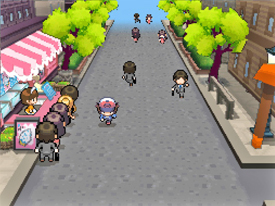
It’s hard to believe that Pokémon Red and Blue came to the United States in September 1998. The titles became instant classics, devouring the attention of both the young and the young at heart.
Almost 13 years later, developer Game Freak and publishers Nintendo and the Pokémon Co. hope to bring that magic back with Pokémon Black and White for the Nintendo DS.
Players will journey in the Unova region, home to 156 brand new Pokémon. Unlike previous titles, Black and White have some subtle touches that provide for a stronger narrative. Trainers travel with two friends, Cheren and Bianca, who are good-hearted rivals. As the journey unravels, they learn about the radical Team Plasma, who want to “liberate” Pokémon from their oppressive masters.
Team Plasma is larger than Red and Blue‘s Team Rocket ever dreamed of being. Among them is N, a foil to trainers who will serve as a strong rival throughout the game as Plasma’s sinister plans are revealed.
Of course, the main point of the games is still to capture and train Pokémon to beat gym leaders and complete the Pokédex. This is where the new Pokémon really come in to play. Purists will hate it — they will have no access to any of the creatures from past games until after the main storyline is over. Exposure to these new Pokémon ignites the sense of exploration from the original games. Trainers will never know what kind of Pokémon they will meet or if they have ever seen the creature before.
That being said, there were already 493 Pokémon in existence prior to Black and White, and only so many more can be great. Some of the monsters are quite imaginative, such as the ice cream Pokémon Vanillite (and its further evolutions), electric zebra Blitzle and all of the starter Pokémon. Others, however, are stale. Lillipup is a rip-off of Red and Blue‘s Eevee without all of the cool evolutions, and Throh, which looks like the Thing from Fantastic 4, is so desperate to prove it’s a fighting type that it wears a karate uniform.
To get to these Pokémon, trainers will need to explore the Unova region. Many of the locations in Unova are cities and suburbs, all surrounding the Manhattan-like Castelia City. This is a departure from the small towns of past games, and the city aura makes the adventure feel grander.
If that wasn’t enough, Black and White display a number of new features. The games add a seasonal calendar in addition to the day and night calendar. Pokémon musicals allow you to dress your Pokémon and prepare them to put on a show.
Trainers will also get to try their hand at three-on-three “triple battles” and a variation called “formation battles” that allow for the use of only one Pokémon per trio to attack at a time.
Other additions include enhanced Wi-Fi and infrared communications, battle and trading through a number of in-game items such as the C-Gear.
Not every new aspect is perfect. The menus in the game were also redesigned for the DS’s touch screen. However, these only show up during battle or when activated by the X button. This leaves players constantly switching between the stylus and buttons unless they choose not to use the touch screen at all.
You can’t forget that there are two versions of Pokémon, as usual. Black and White have some distinct differences, including Pokémon exclusive to each version of the game, a pair of unique gym leaders and an exclusive part of Unova to explore. So to truly “catch ’em all” or see everything, you’ll need to try both games. That being said, trainers will get a complete experience no matter which game they choose.
This experience is one that Nintendo is slowly changing. In Black and White, this change is through the look of the game. The environments look drastically better, and Game Freak has played with camera angles to add new perspectives and depth to the game. It adds a bit of a fresh look to what we’ve seen before.
The Pokémon, however, do not get a makeover. When the camera zooms in, their individual pixels can be seen during battles, making them look rigid. As well, the battles are still two Pokémon facing each other with some special effects. Almost 13 years after the original games, this is starting to seem dated. The hardware can offer more. Without a change, Pokémon is finally showing its age.
Pokémon Black and White provide everything Pokémon has always offered — unique monsters, addicting gameplay and tons to do. If one thing hasn’t changed, it’s that Pokémon is still worth the money. You can play this game for more than 40 hours and still have more to do.
Whether you’re looking to re-experience that childhood feeling or become a Pokémon master once again, Pokémon Black and White deliver. Get your Pokéballs ready.
RATING: 4 stars out of 5
afreedman@umdbk.com



